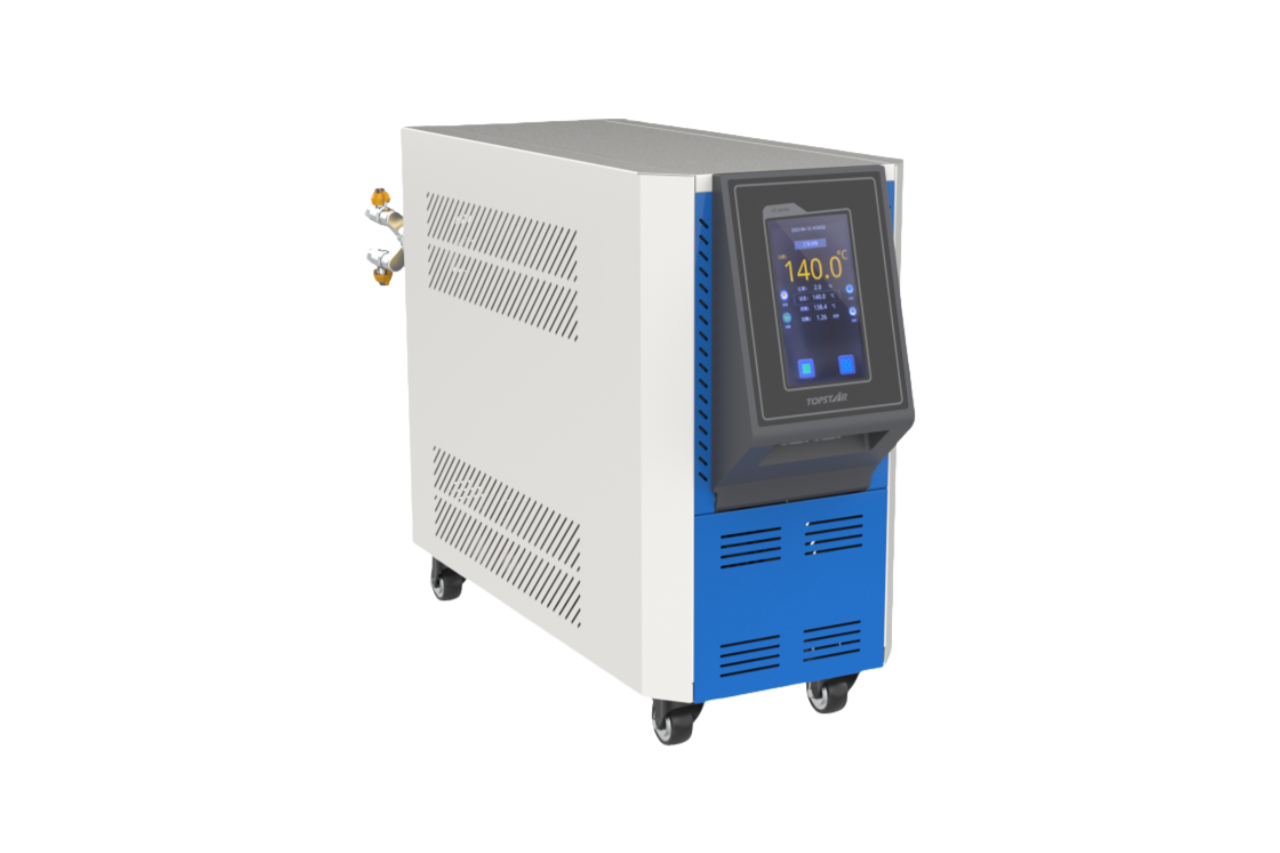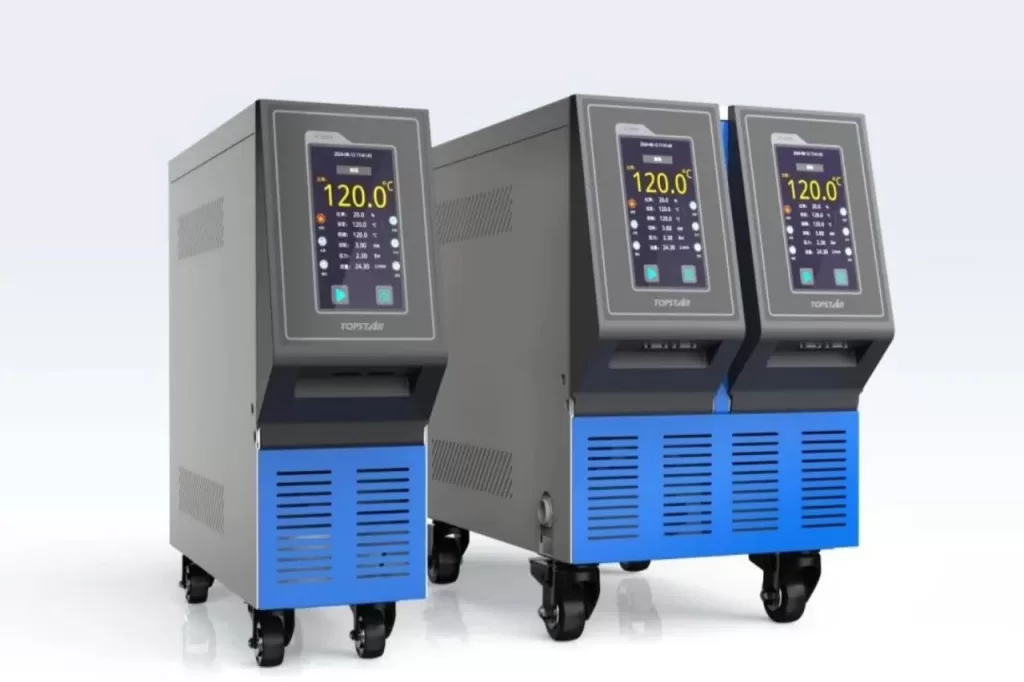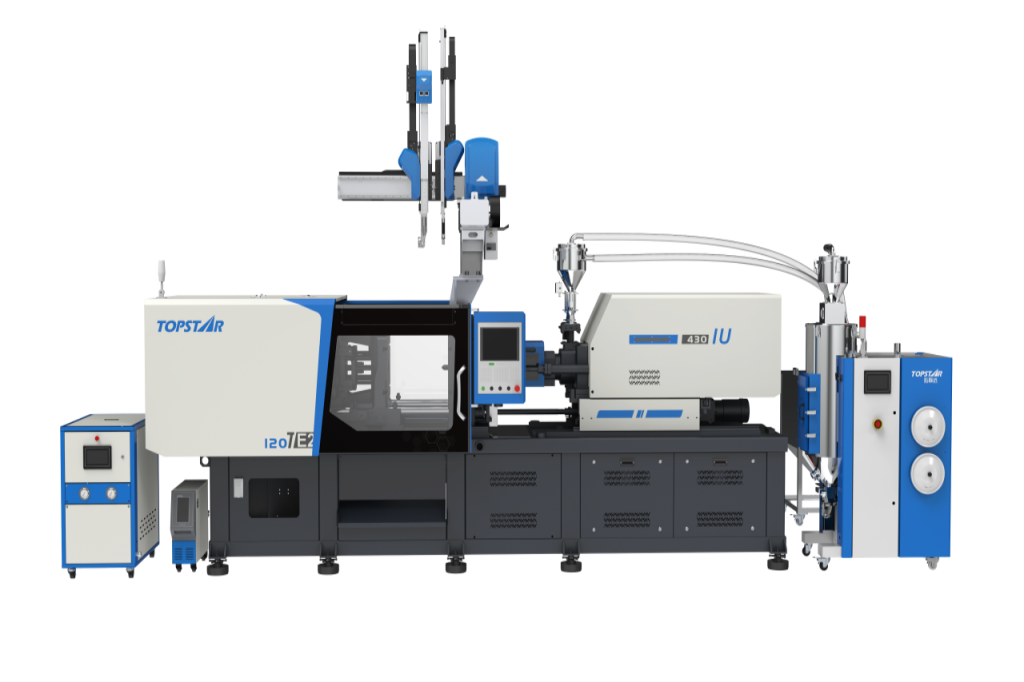Why choose to use intelligent mold temperature controller?
2025/08/20 By le zhan

In the field of industrial automation control, especially in injection molding, traditional mold temperature control systems can lag behind command response, resulting in oscillation, slow settling, or steady-state errors. These hysteresis and delay are not abstract interference factors; they are key drivers of scrap, longer cycle settling times, and unpredictable dimensional variations. Traditional PID loops are effective when the process is dynamically stable and repeatable; however, mould temperature control inherently exhibits delays, nonlinearity, and load dependence. Intelligent mold temperature controllers, on the other hand, upgrade traditional PID methods by integrating adaptive algorithms, predictive compensation, and self-tuning capabilities. This results in faster settling, less overshoot, a more stable temperature range, less manual intervention, and more consistent part quality.
Adaptive Control and Improved Process Stability with Intelligent Mold Temperature Controller
Intelligent mold temperature controllers surpass traditional PID by adjusting their control parameters based on current operating conditions. The injection moulding process is subject to frequent changes during production, including variations in melt temperature, cycle time, mould mass, cavity load, and ambient temperature drift. These variations can degrade the performance of traditional PID loops tuned to a specific operating point. The adaptive control algorithm embedded in the intelligent controller continuously estimates process gains, time constants, and dead time, then updates the controller gains in real-time.
Practically, the controller can reduce overshoot during heating, eliminate oscillatory behavior during steady-state conditions, and shorten the time to reach a stable temperature after process changes. For applications involving multiple molds, recipes, or varying shot sizes, adaptive control eliminates the need for manual readjustment each time conditions change. The result is a consistent mold thermal profile, reduced scrap due to dimensional variations, and faster changeovers.
Enhanced PID Algorithm Reduces Mold Temperature Controller Hysteresis
Traditional PID controllers, while helpful, struggle to cope with the inherent hysteresis and deadtime inherent in mold temperature control systems. Topstar has improved PID controllers in two important ways. First, they implement self-tuning PID. Online parameter identification determines P, I, and D gains based on observed response characteristics, providing better control bandwidth while maintaining stability. Second, intelligent mold temperature controllers typically employ predictive control or feedforward compensation, leveraging a simple process model to predict the impact of heater inputs several seconds in advance.
This dual approach addresses hysteresis. Feedforward terms compensate for known disturbances, such as mould opening and closing cycles, coolant temperature fluctuations, or sudden changes in production speed, allowing the feedback loop to require only minor corrections. This combination minimizes oscillation and ensures the mold remains within the narrow temperature range required for dimensional fidelity.

Power and Heater Management, Energy Efficiency, and Lifespan
In addition to controlling quality, intelligent mold temperature controllers improve energy utilization. Traditional controllers tend to react with maximum heater load during preheating and then oscillate around the setpoint, often wasting energy through on-off cycling. Intelligent mold temperature controllers employ optimized heating profiles that balance ramp rates with thermal stress limits, intelligently distribute heater loads across multiple circuits, and employ soft-start/staged heating strategies to reduce inrush current and mechanical stress on power components. Adaptive regulation of heater output reduces thermal shock to the mold and connected hydraulic or mechanical systems, extending component life and shortening maintenance intervals. Energy consumption is reduced because the mold temperature controller avoids unnecessary overshoot and minimizes cycling losses.
Improving Process Repeatability, Recipe Management, and Integration with Injection Molding Machine Controls
Repeatability is key to high-volume manufacturing. Intelligent mould temperature controllers provide reliable recipe storage and retrieval, allowing operators to apply validated temperature profiles across multiple shifts or machines. These recipes include not only target setpoints but also controlled ramp rates, zone sequencing, and coolant parameters, ensuring consistent thermal regulation for every mold and part series.
Under Topstar’s unified control system, integration with injection molding machines further enhances performance. Communication via industrial protocols enables the mold temperature controller to synchronize with cycle events. For example, the controller can temporarily change the temperature setpoint or enter rapid warm-up mode during startup, then automatically revert to the production profile once stable conditions are restored. This coordinated behavior reduces manual steps, shortens changeover time, and strengthens overall process control. With robust data logging capabilities, quality and maintenance teams have access to a complete thermal history of every production run.

Safety, Alarms, and Fault-Tolerant Operation
Safety and reliability are paramount in industrial automation environments. Intelligent mold temperature controllers offer multi-level protection, going beyond simple overtemperature tripping. They implement multi-level alarm strategies to help operators resolve issues before they escalate.
Fault tolerance is another key design priority. The mould temperature controller features a redundant sensing architecture and fail-safe shutdown capabilities to safeguard the mould and machine in the event of a critical failure. Redundant temperature sensors in each zone can be cross-checked to detect sensor drift or disconnection. If necessary, the intelligent mold temperature controller can be configured to use a majority voting mechanism between sensors or degrade to a safer, lower-power mode until maintenance intervention is required. Furthermore, the intelligent controller supports secure remote access and firmware management. Authorized maintenance personnel can review logs, update control strategies, and apply vendor-approved firmware to fix known issues.
Choosing an intelligent mold temperature controller to meet the needs of more sophisticated product production
Choosing an intelligent mold temperature controller is a pragmatic response to the practical constraints of thermodynamics, delays, and variability in the injection molding process. The intelligent mold temperature controller’s adaptive regulation, predictive operation, coordinated heater management, integrated recipe control, and robust safety features transform temperature control from a recurring pain point into a stable, repeatable asset in the production process, meeting the needs of more sophisticated product production.
Frequently Asked Questions (FAQs)
- What is the difference between an intelligent mold temperature controller and a conventional PID controller?
The intelligent controller combines self-tuning PID control with predictive strategies and adaptive scheduling. This enables it to adjust gains in real time to accommodate changing thermal mass, coolant conditions, and load variations. In contrast, conventional PID controls maintain fixed gains that decrease as conditions change. - How much maintenance is required?
Because intelligent features reduce stress on the heater and mold, maintenance is typically less frequent. Routine maintenance includes sensor calibration checks, heater circuit checks, and firmware updates. Predictive alerts often notify you of potential problems before they escalate, enabling planned maintenance rather than emergency repairs. - Does intelligent temperature control reduce energy consumption?
Yes. By avoiding overshoot, minimizing cycling losses, and optimizing heating stages, the mold temperature controller can use energy more efficiently.
Related recommendations: Fourth-generation mold temperature controller
TRENDING POSTS
- TOPSTAR Global Open Day 2025: Humanoid Robot Debuts, Pioneering a New Decade of Intelligent Manufacturing 2025/08/20
- Topstar Showcases TE II Electric Injection Molding Machines at InterPlas Thailand 2025 2025/08/20
- Topstar Expands Its Ecosystem Partnerships to Drive Smart Manufacturing Innovation 2025/08/20
- What factors can cause delays in the injection molding process of plastic molding machine? 2025/08/20
HOT TOPIC
- .ervo motor-driven linear robots
- •
- 1.0 guangdong topstar technology co. ltd
- 1.0 topstar china
- 1.0 topstar robot
- 11
- 160℃ mold temperature controller
- 170 ton injection molding machine
- 2
- 21
- 220-ton injection molding machine
- 23
- 260 ton injection molding machine
- 3 axis robot
- 3 axis robots
- 3 in 1 Compact Dehumidifying Dryer
- 3-axis robot
- 3-axis robots
- 39
- 41
- 460T injection molding machine
- 5-axis CNC machine
- 62
- 90 ton injection molding machine
- accuracy
- Air Chillers
- all electric injection molding machine
- all electric injection molding machines
- all-electric injection molding machine
- All-electric injection molding machines
- and overall production quality. Therefore
- AP-RubberPlas
- automated injection molding machine
- Automation changed engineering
- automation of injection molding robots
- automotive parts injection molding
- auxiliary machine
- Bench Injection Molding Machine
- Cabinet dryer manufacturers
- Cabinet dryers
- chiller
- CNC Drilling Machine
- CNC Drilling Machines
- cnc engraving machine manufacturer
- cnc laser cutting machine manufacturer
- CNC machine
- CNC Machine Center
- CNC Machine for Sale
- CNC Machine Manufacturing
- CNC Machine Tool
- CNC machine tool product
- CNC Machining Center
- CNC wood carving machine
- Cooling system
- Cross-Walking Single Axis Servo Cylinder Robot
- Cross-Walking Single-Axis Servo Cylinder Robot
- Cross-Walking Three-Axis/Five-Axis Servo Driven Robot
- cross-walking three-axis/five-axis servo-driven robot
- Dehumidifier Dryer
- Dehumidifying Dryer
- delta parallel robot
- Desktop Injection Molding Machine
- Desktop injection molding machines
- Desktop Molding Machine
- desktop plastic injection machine
- Desktop Plastic Injection Molding Machine
- Digital Transformation
- direct clamp injection molding machine
- Direct clamp injection molding machines
- Dosing & mixing system
- Drilling Centers
- Drying and dehumidification system
- drying and dehumidifying equipment
- Drying and Dehumidifying System
- drying system
- effective and efficient. Cabinet dryers are also used in other industries where large quantities of material need to be dried
- efficient injection molding machine
- elbow hydraulic injection molding machines
- electric injection molding machine
- electric injection molding machines
- energy-efficient injection molding robot
- energy-efficient water chiller
- energy-efficient water chillers
- energy-saving injection molding machine
- etc. Among injection molding robots
- exhibition
- features of CNC machine
- Feeding And Conveying System
- Five Axis Machine Center
- Flexible Production Line
- Fully automatic injection molding machine
- Gathering Topstar
- giant injection molding machine
- GMU-600 5-Axis Machining Center
- Granulating & Recycling System
- Heavy duty injection molding machine
- High-precision electric molding machines
- high-precision plastic molding machines
- high-speed all electric injection molding machine
- high-speed electric injection molding machine
- High-Speed Packaging Injection Molding
- Honeycomb rotor dehumidifier
- horizontal injection molding machine
- Horizontal Injection Molding Machines
- Horizontal Injection Moulding Machine
- Horizontal Mixer manufacturer
- How The CNC Machine Works
- hybrid injection molding machine
- hydraulic injection molding machine
- Hydraulic Injection Molding Machines
- in this article
- Industrial AI
- Industrial Automation
- Industrial robot
- Industrial Robot Chinese brand
- industrial robot parts
- industrial robot supplier
- Industrial robots
- Industry Chain
- Injection Manipulator
- injection manipulator robot
- injection mold machines
- Injection molding
- Injection molding automation
- Injection Molding Automation Solution
- injection molding dryer
- Injection molding equipment
- injection molding hopper dryer
- Injection molding machine
- injection molding machine brand
- Injection Molding Machine Factory
- Injection Molding Machine Manufacture
- Injection molding machine manufacturer
- injection molding machine manufacturers
- Injection molding machine procurement
- injection molding machine robotic arm
- injection molding machine with a robot
- Injection molding machines
- injection molding material dehumidifying
- injection molding plant
- injection molding process
- Injection Molding Robot
- injection molding robot arm
- Injection molding robot automation
- Injection molding robotic arm
- injection molding robots
- Injection moulding machine
- injection moulding machines
- Injection Moulding Robots
- Injection Robot
- Injection robot arm
- Injection robot manufacturer
- Injection robot wholesale
- injection robots
- Intelligent Factory
- intelligent injection molding machines
- Intelligent Manufacturing
- intelligent mold temperature
- intelligent mold temperature controller
- Intelligent mould temperature controller
- InterPlas Thailand 2025
- Introducing Injection Robot
- It is the best choice for drying large quantities of material at once. Cabinetmakers use these machines because they are fast
- Large flow water type mold temperature controller
- large injection molding machine
- large injection molding machines
- Learn what industrial automation and robotics is
- linear robot
- linear robots
- low speed sound-proof granulator
- machine plastic molding
- make sure to add some! Improvements (2) Keyphrase in introduction: Your keyphrase or its synonyms appear in the first paragraph of the copy
- manipulator machine
- manufacturing
- Manufacturing Innovation
- medical grade injection molding machines
- Medical Injection Molding
- medical injection molding machine
- medical injection molding machines
- micro injection molding machine
- middle speed granulator
- Mini CNC machine manufacturers.
- mobile cover making machine
- Mold Temperature Control System
- mold temperature controller
- mold temperature controllers
- molding machine
- molding material Dehumidifying System
- mould temperature control system
- mould temperature controller
- mould temperature controllers
- New electric injection molding machine
- nitrogen dryer manufacturer
- nitrogen dryer system manufacturer
- Oil type mold temperature controller
- Oil type mold temperature controllers
- open day
- optical component injection molding
- Outbound links: No outbound links appear in this page. Add some! Images: No images appear on this page. Add some! Internal links: No internal links appear in this page
- packaging injection molding
- Packaging Solutions
- PET Preform injection molding
- phone case maker machine
- phone case making machine
- phone cover making machine
- PID Control Mold Temperature Controller
- plastic bottle making machine
- plastic bottle manufacturing
- plastic bucket making machine
- plastic bucket manufacturing
- Plastic chair making machine
- plastic forming equipment
- plastic hopper dryer
- plastic injection machine
- plastic injection machines
- plastic injection molding
- Plastic injection molding equipment
- Plastic injection molding machine
- Plastic Injection Molding Machines
- plastic injection moulding machine
- plastic injection moulding machines
- plastic injection robot
- plastic molding
- Plastic Molding Industry
- Plastic Molding machine
- plastic molding machine 1
- Plastic Molding Machines
- plastic molding press
- plastic moulding machine
- plastic phone case making machine
- plastic-molding machine
- powerful granulator
- Powerful Type Sound-Proof Granulator
- precision injection molding
- precision injection molding machines
- production of plastic seats
- pure water mould temperature controller
- Robot injection molding
- robot injection molding machine
- robot manufacturing companies
- Robotic arm for injection molding machine
- robotic injection molding machines
- robotics in injection molding
- SCARA robot
- SCARA robots
- Service-oriented manufacturing
- Servo Cylinder Robot
- servo driven robot
- Servo Driven Robots
- servo injection molding machine
- servo injection robots
- servo motor-driven linear robots
- servo-driven 3-axis robot
- Servo-driven injection molding machine
- Servo-Driven Robot
- Setup of injection machine
- Silicone Injection Molding Machine
- six-axis industrial robot
- Smart Manufacturing
- Stainless Hopper Dryer
- Stainless Hopper Dryers
- star club
- swing arm robot
- take-out robot
- take-out robots
- Thailand 4.0
- the choice between servo-driven robots and hydraulic robots will have a certain impact on efficiency
- the most popular injection molding machine
- the type of injection molding robot
- TIC2000 Control System
- TMII injection molding machine
- toggle clamp injection molding machine
- Toggle Hydraulic Injection Molding Machines
- toggle injection molding machine
- Top 10 brands of injection robots
- Topstar
- Topstar Electric Injection Molding Machine InterPlas Thailand 2025 Smart Manufacturing Thailand 4.0
- Topstar Engineering
- Topstar Industrial Robots
- Topstar injection molding intelligent
- Topstar Scara Robots
- Useful Injection molding machine
- Vertical machining centers
- volumetric type blender
- water chiller
- water chillers
- water distributor
- water type mold temperature controller
- Water Type MoldTemperature Controller
- Water-Type Mould Temperature Controllers
- We often face choices when performing injection molding. We will choose the type of injection molding machine
- wholesale of injection molding machines
- x carve CNC
- 热门查询 点击次数 展示 排名 topstar
